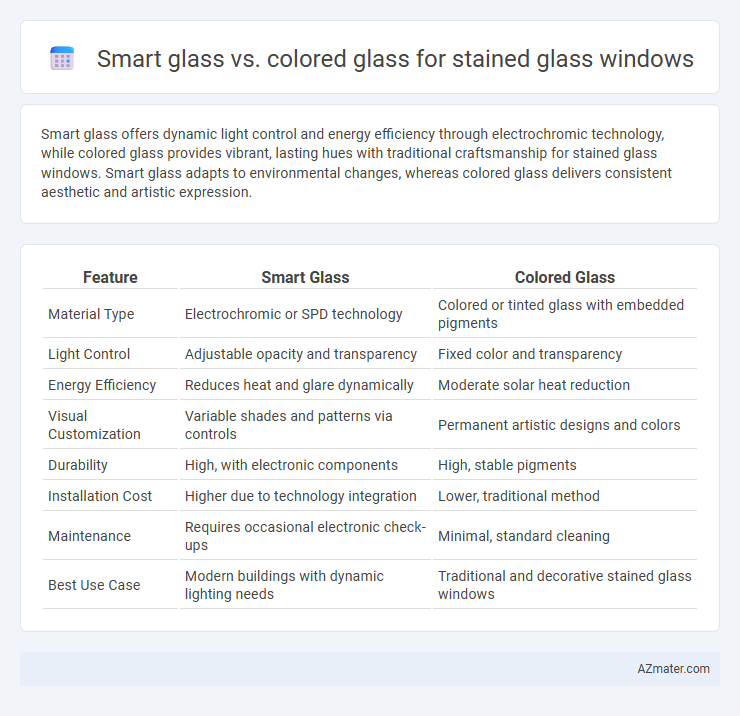Smart glass offers dynamic light control and energy efficiency through electrochromic technology, while colored glass provides vibrant, lasting hues with traditional craftsmanship for stained glass windows. Smart glass adapts to environmental changes, whereas colored glass delivers consistent aesthetic and artistic expression.
Table of Comparison
| Feature | Smart Glass | Colored Glass |
|---|---|---|
| Material Type | Electrochromic or SPD technology | Colored or tinted glass with embedded pigments |
| Light Control | Adjustable opacity and transparency | Fixed color and transparency |
| Energy Efficiency | Reduces heat and glare dynamically | Moderate solar heat reduction |
| Visual Customization | Variable shades and patterns via controls | Permanent artistic designs and colors |
| Durability | High, with electronic components | High, stable pigments |
| Installation Cost | Higher due to technology integration | Lower, traditional method |
| Maintenance | Requires occasional electronic check-ups | Minimal, standard cleaning |
| Best Use Case | Modern buildings with dynamic lighting needs | Traditional and decorative stained glass windows |
Introduction to Stained Glass Windows
Stained glass windows, renowned for their vibrant colors and artistic designs, traditionally use colored glass to create intricate patterns that transform natural light into vivid displays. In contrast, smart glass technology offers dynamic control over light transmission, enabling windows to switch between transparent and opaque states for privacy and energy efficiency. Combining traditional stained glass artistry with smart glass innovation enhances functionality while preserving aesthetic appeal in architectural design.
What is Smart Glass?
Smart glass, also known as switchable glass, is a type of glass that can change its light transmission properties when an electrical current or heat is applied, offering dynamic control over transparency and privacy. Unlike traditional colored glass used in stained glass windows, which relies on fixed pigments and designs, smart glass provides adaptability by shifting from opaque to transparent states. This technology enhances energy efficiency and comfort by regulating natural light and reducing glare without compromising aesthetics.
What is Colored Glass?
Colored glass is glass that has been infused with metal oxides or other additives during its manufacture to produce vibrant hues, commonly used in stained glass windows to create artistic and decorative effects. This type of glass preserves traditional craftsmanship and allows for intricate designs by combining different colors and textures. Unlike smart glass, which changes properties with applied stimuli, colored glass maintains a constant appearance, providing timeless aesthetic appeal in architectural settings.
Key Differences Between Smart Glass and Colored Glass
Smart glass uses electrochromic technology to change opacity or color dynamically, offering adjustable light transmission and privacy control. Colored glass, made by adding metal oxides or dyes during production, provides fixed hues and patterns with permanent optical properties. Key differences lie in smart glass's versatility for energy efficiency and light modulation, while colored glass emphasizes artistic expression and traditional aesthetics.
Aesthetic Qualities: Smart Glass vs Colored Glass
Smart glass offers dynamic transparency control, allowing users to adjust light and privacy levels while maintaining a sleek, modern aesthetic that adapts to changing environments. Colored glass provides rich, permanent hues and intricate patterns that create vibrant, artistic expressions but lacks the versatility in light modulation found in smart glass. The choice hinges on whether static beauty or adaptable ambiance is prioritized in stained glass window design.
Energy Efficiency and Insulation Properties
Smart glass offers superior energy efficiency compared to colored glass by dynamically controlling solar heat gain and visible light transmission, reducing the need for artificial cooling and lighting. Colored glass provides consistent insulation through its tinted layers but lacks the ability to adapt to changing environmental conditions, resulting in less optimized energy usage. Enhanced insulation properties in smart glass contribute to maintaining indoor temperatures, lowering energy costs significantly in stained glass window applications.
Cost Comparison: Installation and Maintenance
Smart glass for stained glass windows typically features higher upfront installation costs due to advanced electrochromic technology, ranging from $250 to $600 per square foot, compared to colored glass, which generally costs between $100 and $300 per square foot. Maintenance expenses for smart glass include potential electronic component repairs and software updates, increasing long-term costs, whereas colored glass requires minimal upkeep, usually limited to cleaning and occasional sealing. The cost efficiency of colored glass remains favorable for budget-sensitive projects, while smart glass offers dynamic functionality that may justify its premium pricing in specialized applications.
Applications in Modern and Traditional Settings
Smart glass offers dynamic light control and energy efficiency, making it ideal for modern stained glass windows in commercial and residential buildings that prioritize sustainability and privacy. Colored glass, with its rich hues and intricate designs, remains favored in traditional settings such as churches and historic restorations, providing vibrant aesthetics and cultural symbolism. Both materials serve distinct roles, with smart glass enhancing functionality and colored glass preserving artistic heritage in stained glass applications.
Durability and Longevity Considerations
Smart glass offers enhanced durability with its advanced laminated and tempering technologies, providing increased resistance to impact, scratches, and environmental wear compared to traditional colored glass. Colored glass, while aesthetically rich, can be more susceptible to fading and chipping over time due to UV exposure and physical stress. In terms of longevity, smart glass maintains color clarity and structural integrity longer, making it a more resilient choice for stained glass window installations in high-traffic or exterior settings.
Choosing the Right Glass for Your Stained Glass Window
Smart glass offers dynamic light control and energy efficiency for stained glass windows, adapting to changing sunlight and enhancing privacy without sacrificing design. Colored glass provides vibrant hues and traditional craftsmanship that delivers rich, artistic expression and timeless aesthetic appeal. Selecting the right glass depends on balancing modern functionality with classic visual impact to achieve your desired atmosphere and performance.

Infographic: Smart glass vs Colored glass for Stained glass window
 azmater.com
azmater.com